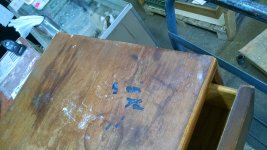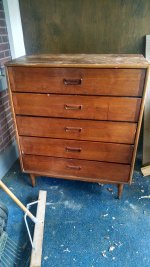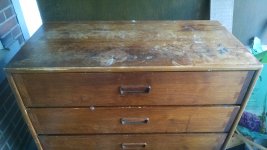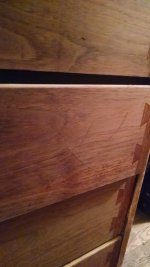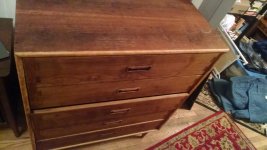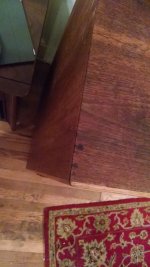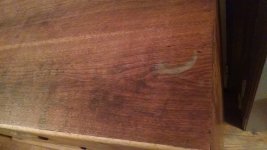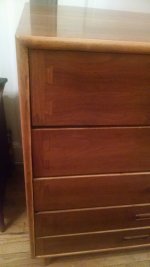Short story time:
My girlfriend moved in last weekend [big grin] and brought with her the sorriest pine dresser I ever saw. The whole thing is held together with staples, and it looks like it was built out of scrap flooring. Fortune smiled upon us, though, as we stopped by the local reuse center and dropped off some recycling. As is my habit, we walked through the furniture section looking to see what hidden gems might be available, I saw a dresser that looked a lot like a coffee table I have in my basement.
I asked my girlfriend if she saw any stamps in the drawers, and she did. The dresser turned out to be from the Lane Acclaim series. It fits our style a lot better, and I think it will be better storage than what she has now. So at $50, the price was right and we grabbed it.
Now the challenge is to clean it up and fix up some of the damage to the veneer. There's a fair amount of water marks on the top and some scratches and chips on the case and a couple of the drawer faces. The body is solid, though, and the legs look to be in great shape.
Here's where we're starting from - excuse the mess, as I don't have much room to put things indoors right now.
My girlfriend moved in last weekend [big grin] and brought with her the sorriest pine dresser I ever saw. The whole thing is held together with staples, and it looks like it was built out of scrap flooring. Fortune smiled upon us, though, as we stopped by the local reuse center and dropped off some recycling. As is my habit, we walked through the furniture section looking to see what hidden gems might be available, I saw a dresser that looked a lot like a coffee table I have in my basement.
I asked my girlfriend if she saw any stamps in the drawers, and she did. The dresser turned out to be from the Lane Acclaim series. It fits our style a lot better, and I think it will be better storage than what she has now. So at $50, the price was right and we grabbed it.
Now the challenge is to clean it up and fix up some of the damage to the veneer. There's a fair amount of water marks on the top and some scratches and chips on the case and a couple of the drawer faces. The body is solid, though, and the legs look to be in great shape.
Here's where we're starting from - excuse the mess, as I don't have much room to put things indoors right now.

